Scientific Drilling | Paso Robles - Virtual Tour
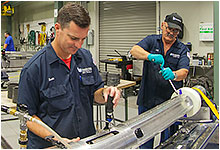
Welcome to the 360 degree Virtual Tour of Scientific Drilling International -- Applied Technologies Center. The tour will transport you through the Applied Technologies Center, providing information and media across multiple stages of the design, manufacturing, and testing process.

Front Entrance
Welcome to the 360 degree Virtual Tour of Scientific Drilling International – Applied Technologies Center. This highly technical, multi-building R&D facility is nestled in the coastal mountain range of central California, home to a thriving wine and agriculture industry. Scientific Drilling (SDI) is an independent energy service provider offering a complete high accuracy navigation and drilling solution to the O&G, Unconventional, Geothermal and Mining industries. SDI employs over 2,300 people across 45 locations in 26 countries. This facility designs, engineers, manufactures, and tests all downhole technology for the entire company.
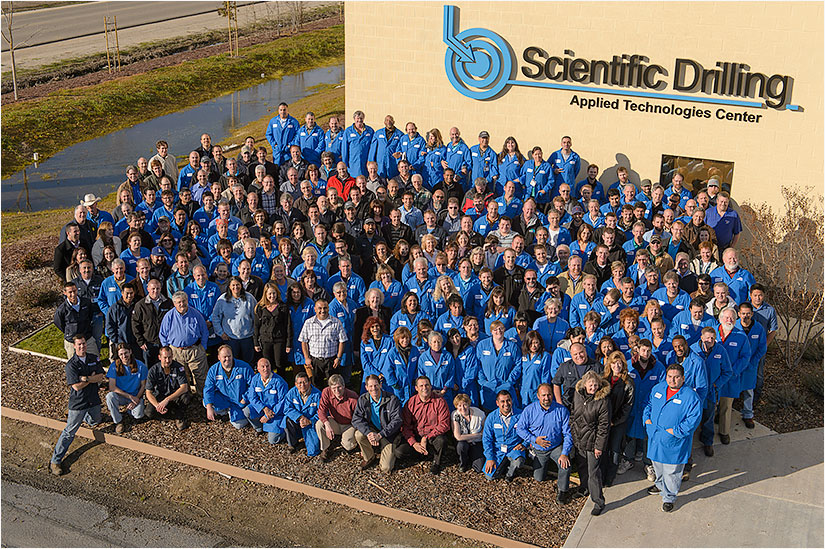
Our People
ATC employs over 370 people in Paso Robles, CA, making them the largest private employer in Paso Robles.This includes:
- 155 Technicians
- 16 Manufacturing Engineers
- 90 Engineers (Mechanical, Electronics, Software, Telemetry, System and Nuclear)
Our Campus
The Applied Technologies Center (ATC) campus has seven buildings totaling over 100,000 sq. ft. Within the campus there is over 42,000 sq. ft. of assembly floor, 3,200 sq. ft of prototype machine shop, and 26 heated tool calibration and test stands.ATC is investing in new or upgrading 25,000 sq. ft. of additional roofline.
Downtown Paso Robles, CA
Scientific Drilling's Applied Technologies Center is 5 miles from Downtown Paso Robles.About Paso Robles
Paso Robles Chamber of Commerce

Reception
Welcome to Scientific Drilling, Applied Technologies Center! This is the main entrance to the ATC Campus and where all guests, or customers will enter. Upon arrival, please sign in and we will ensure the person or team you are here to visit will be with you momentarily.
ATC is a manufacturing facility with strict PPE requirements in specific areas. We advise that you do not walk around without an ATC employee and ensure you are wearing proper PPE.

Production
Our General Production Team consists of 25 Electro-mechanical Assemblers and 18 Test Technicians to support MWD, LWD, Cased Hole, and Survey product families. Up to 40 different downhole and surface support products built, maintenance and/or repaired weekly; including hundreds of sub-assemblies and PCBAs. Approximately 84 tools a week are delivered to finished goods. All Assembly and Test personnel are IPC Class III trained in soldering insitu inspection. Production Test houses seven auto/manual calibration stands and over a dozen flexible calibration ovens and test stations.
Production Area
Electronic Technician performing pre-calibration setup; installation of firmware, tool personality and characterization profiles. Each tools has an imbedded memory including serial number Identification, firmware revision and calibration data.(Tool pictured: Gamma Tool)
Production Team
Assembler working on MWD Eye tool.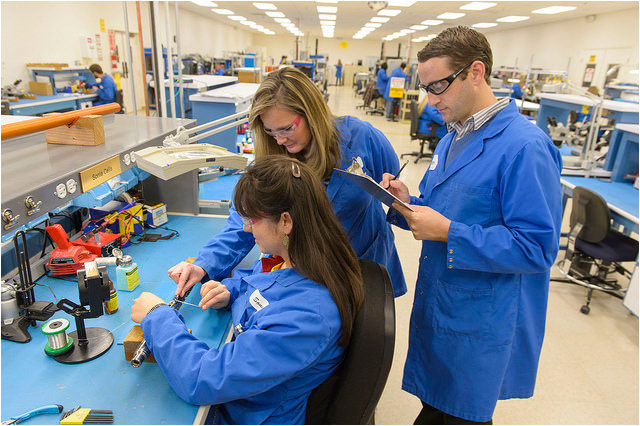
Production Team
Quality Inspectors and production staff are trained by our in-house, certified CIT trainers.Production Area Signage
Product Line designations above each process station.MWD/LWD test
MWD/LWD Test: Tools calibrated and qualified in automated ovens/stands for positional accuracy over temperature to ensure top performance. Flexible production line allows 3 operators to run multiple test stations.ESD Mats
ESD (Electrostatic Discharge) Controls protects products from potential hidden and harmful ESD exposure. Proper storage, transportation, work space delineation, signage and PPE (Personal Protective Equipment) ensures safety for employee and product.
Systems Verification Lab
The Systems Verification Lab is the last stop in the development process before a design moves out to the field. After the design engineers have tested their updates or new tools, the changes are tested at the system level to ensure there are no ill effects on any of the other tools in the string. The Systems Verification Lab also plays an integral role in the timely resolution of NCRs by providing an environment to reproduce issues reported from the field so they can be diagnosed and resolved quickly.
Some testing capabilities include:
- Varying the inclination of a tool string between 0° and 95°
- Rotating a tool string up to 200 rpm
- Reproducing vibration and rotation profiles from past jobs
Work Spaces
Ample work surfaces to recreate most tool string configurations.Trebuchet
Allows for fully scripted automated testing of either a rotating or stationary tool string at any inclination between 0° and 105°.Tool Rack
Provides safe storage of heavy pressure barrels while not being used for testing.Storage
Easy access, safe storage of common tool string components.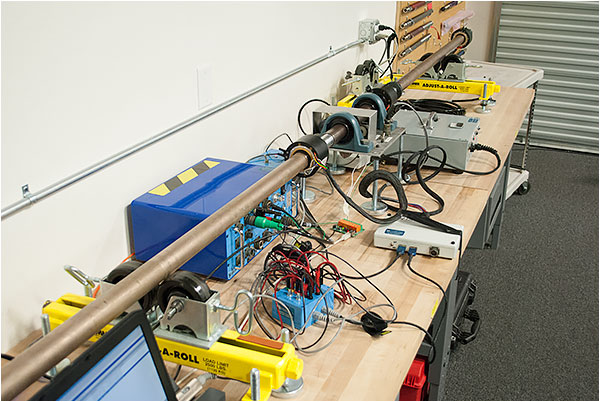
Rotating Test Stand
Allows for testing that requires mode changes between rotating and sliding as well as hemispherical binning of azimuthal gamma tools.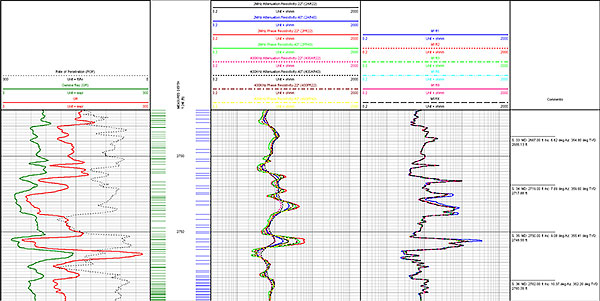
Multi-Use Monitor
● Used to collaboratively view system level or tool level schematics● View data sheets of electronic components
● Collaborative high level data review
● Classroom training
● Display of real-time data from tools used in trebuchet
Manual Test Stand
Allows manually controlled temperature and positioning of tools. Primarily used for verification of steering tools such as Keeper and steering software such as wKDAC and KMAC.Flexible Design Access Door
Facilities designed for easy access to accommodate larger collar based tool testing.Automated Test Stand
Allows computer-controlled temperature and positioning of tools. Primarily used for verification of steering tools such as Keeper and steering software such as wKDAC and KMAC.Facilities Design
Facilities designed with capabilities to test EM communication (both decoding real-time telemetry as well as down-link messages) using true earth grounding stakes.
Collar Based Tool Lab
The Collar Based Tool Lab at SDI's Applied Technology Center has supported the Company's flagship Rotary Steerable System development through to the commercialization of the SRX 740 fleet and the ongoing field trials of the prototype SRX 650 system. Fully equipped with an overhead crane and hydraulic break-out unit, our team of Engineers and Technicians are able to complete any level of diagnostic investigation, repair and rebuild required to support a continuous multi-well test program.
Electronic Bay Cover
Installation of electronic bay cover. Eight covers around the Middle Housing of the SRX 650 provide protection to the electronics modules from borehole fluids.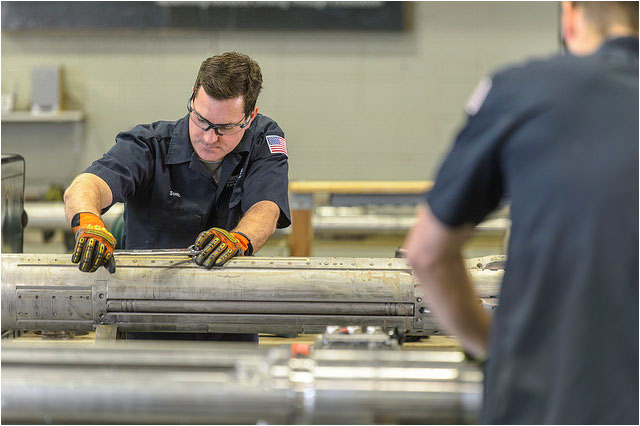
Electronic Control Module
Installation of electronic control module into tool housing. SRX 650 was designed with a modular approach for ease of assembly and servicing.Mobile Tool Cart
Mobile tool cart used for electronics wiring, sub assembly construction, and component inspection.Surface Test
Nearly complete SRX 650 tool being put through a surface test prior to final assembly.Hydraulic Cart
Hydraulic Test Cart provides consistent, high pressure water supply to SRX Tools during testing and calibration.Prototype Development
Prototype development of a new collar based resistivity tool taking place in the SRX Lab.Pressure Test Station
Used for accelerated life cycle testing of various components and sub-systems of the SRX 650.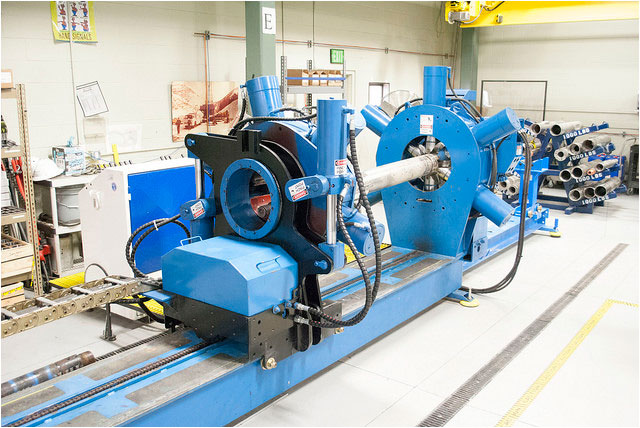
Break Out Unit
Used for tool assembly and torquing of collar connections.
Covered Patio
ATC's covered patio opened in the spring of 2013 and since then has become a favored location for breaks and enjoying lunch. The patio also provides a lovely location for company BBQs and special events.
Rollie Gates Building
The Covered Patio separates two main buildings at ATC, Rollie Gates and Van Steenwyk. The Rollie Gates Building is where you will find Reception, Administration, the Production Area, Collar Based Tool Lab and Systems Verification Lab among other operations.Lunch
Employees enjoying the beautiful weather in Paso Robles, CA, eating lunch together.
Diagnostics
The MWD/LWD Diagnostic department goals are to provide customers quality and timely feedback regarding nonconformance (NCR) incidents, supporting field demand as well as collecting reliability data for engineering. The team is heavily involved in data analysis and attempting to reproduce failures experienced in the field to better understand and improve the quality of our products. In addition to addressing failures, the team also inspects maintenance tools and equipment for needed repairs and upgrades. NCR Statistics
- Since January 2014 average NCR resolution time has dropped from 26 to 6 days (July 2014).
- Since April 2014, diagnostics has received an average of 217 NCRs and has resolved an average of 222 NCRs each month.
- NCR queue reduced from 143 in February 2014 to 26 in July 2014.
Maintenance Statistics
- Since April 2014, diagnostics has received an average of 131 maintenance tools and completed an average of 146 maintenance tools each month.
- Maintenance queue reduced from 234 in April 2014 to 109 in July 2014.
Tool Oven
The oven is an important tool for Diagnostics. It is used to temperature test tools whose failures are intermittent and only appear at elevated temperatures.Tool Racks
These organize the tools waiting to be worked on.Racks against the wall organize our incoming area where our clerk makes sure we have all the information we need to investigate a failure and then sorts accordingly.
Battery Storage
Employee sorting batteries soon to be inspected by technicians.Electromagnetic MWD Test Station
Employee is using MWD Run to test an EM5. MWD Run and other DataModel applications are used to view settings and field (run) data to determine how the tools were operated in the field, confirm the failure description the field was complaining about and find evidence as to why the failure may have occurred (settings, temperature, vibration, etc.).Failure Analysis
Employee removing MWD Eye from rack to being failure analysis.Mud Pulse MWD Test Station
The laptop is displaying a WinLog plot. WinLog is a frequently utilized tool in Diagnostics. It gives the technicians the ability to see the environmental, rig and sensor information side by side to determine if there are any correlations or patterns around the failure. This information can help the technicians pinpoint what caused failures and assist them in reproducing the failure in the lab.This employee is inspecting an RFC which is the mechanical connection between tools in a string. Failures in RFCs can cause communication errors, power loss to tools, etc.
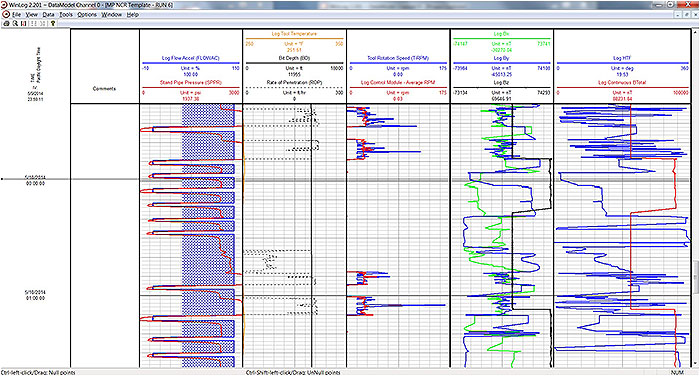
Work Station
The blue box (MSI) behind an MP6 tool is used to download MP6 ASCII logs. These logs contain valuable information about the environment downhole and the data can be displayed in a WinLog plot for interpretation.
Finished Goods
Finished Goods is home to over 1500 different products. These products range from o-rings and setscrews, to cabling and running gear, to surface equipment and downhole electronics. We process an average of 91 orders per week as a distribution center for all SDI locations worldwide. Inventory is carefully monitored with daily cycle counts resulting in a sustained inventory accuracy of over 99%.
Over the last 7 months we have shipped 174,993 pieces, averaging 24,999 per month.
Loading Order
Finished Goods supplies the field with tools and equipment needed to run jobs. This can be individual parts or complete kits. Here an employee is loading a Smart Motor kit for deployment to the field.Safety First
Safety is our #1 priority. Employees are required to complete a variety of safety courses yearly.Green Tags
Green tags on equipment indicate it is a used/repaired part that has been thoroughly tested and is ready to be sent back to the field.Finished Goods Process
The Finished Goods department receives an order from a district where it is processed, pulled and delivered to the shipping department. The shipping department packs the order and creates the required shipping documents.Finished Goods Process
Customer orders are loaded on a cart as equipment is pulled from the shelves. Once the order is complete, it will be wheeled to the shipping department for packing and final processing.Filling an Order
An employee with a gap pack, filling an order for our Casper district.Centralizer Storage
The type of centralizer needed for a job depends on the tool being used and the application. Here are several types of centralizers, stocked and ready to ship.
Machine Shop
The prototype shop at ATC is where the ideas of the engineers become actual parts. With the machines we have in our inventory, we have the capability of fabricating almost any part from plastic, aluminum or steel, in sizes ranging from very small to needing a forklift. Our machinists have an average of over 20 years of machining experience.
Safety Floor
Shop floor is an epoxy coated non skid surface.Safety Floor Mats
Anti-fatigue mats.Overhead Crane
Overhead crane for loading and unloading mill.Machine Shop Tools
Programmable horizontal saw.Quality Control
One of the machinists measuring a feature between machining operations.Machine Shop Organization
Rotating storage for easy access to small pieces of material.SL-20 Turret Lathe
This lathe can be programmed with up to 10 tools.
Keeper Test Lab
Lab supports new build of sensor sections as well as repairing tools coming back from the field. Current fleet size is 670 tools. An average of 11 tools come back every week for maintenance or repair. There are 15 auto stands and 6 manual stands with an average of 22 tools moving through the stands each week. Each tool spends about 60 hours in the stand for testing and calibration. The crew consists of assemblers, test technicians that run the stands and technicians to diagnose failures and resolve field NCR’s. Every sensor sections receives a X & Z gyro and accel that was built in our Cleanroom.
Keeper Auto Test Stand
Each tool spends an average of 50 hours in this stand for calibration purposes. The stand movements are fully automated.Root Cause Failure Analysis
Our Electronic Technician team diagnoses all mechanical and electronic failures that occur in our Survey tools. They strive to provide root cause failure analysis to help improve our products.Keeper Manual Test Stand
There are 6 manual stands in the lab used in the calibration process.
Gyro Assembly Clean Room
All Gyros are hand built and calibrated by a crew of 23 assemblers and technicians in a class 1000 cleanroom. The team builds 25 different gyro sub-assemblies to produce a combination of X and Z Axis gyros and a rate of 85 per month. Our custom designed/built Laser Motor Balancer has increased motor weekly throughput by 75%.
Motor Balancer
Old motor balancer on the left and new laser balancer on the right with a technician loading a motor.Laser Balancing Machine
Gyro Technician loading a gyro motor in our Laser Balancing Machine.This machine reduces average balance time from 45 minutes to 10 minutes.